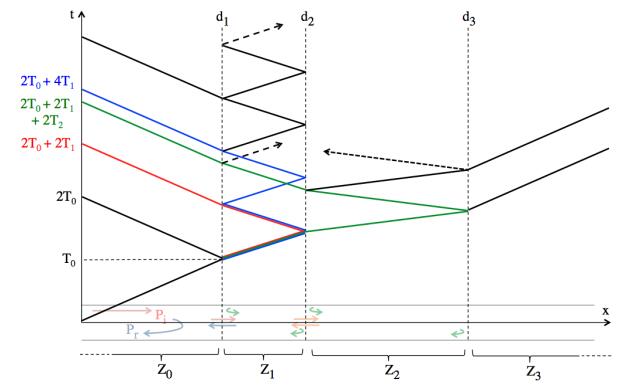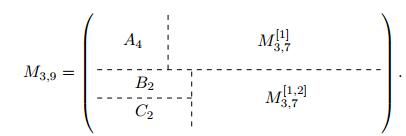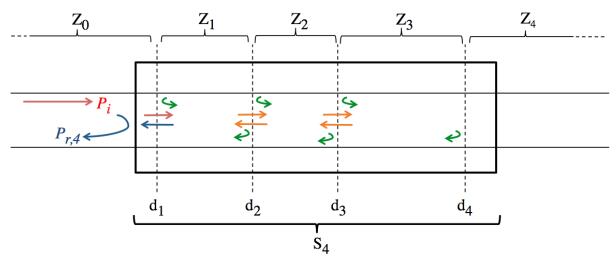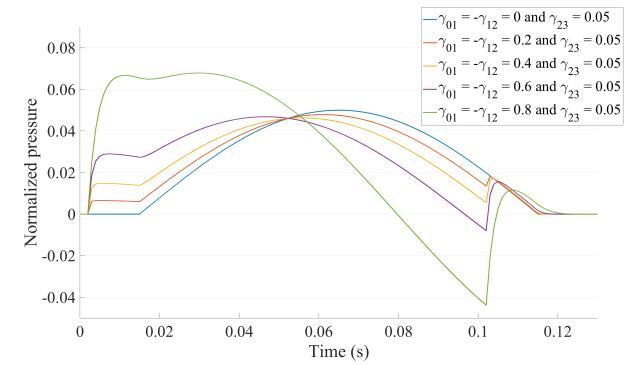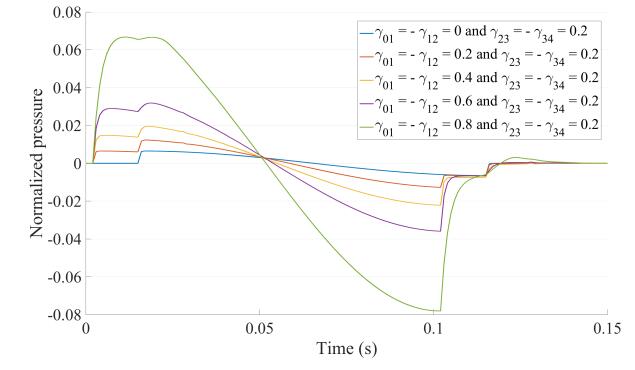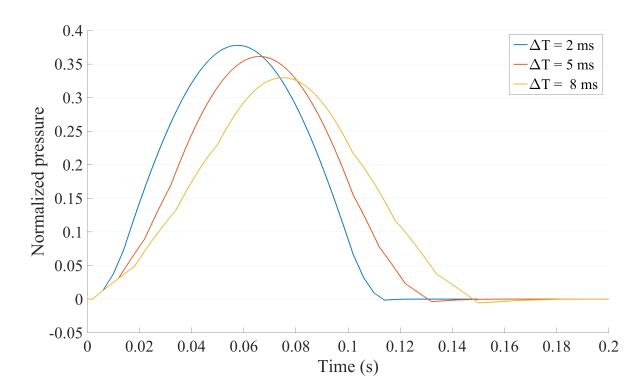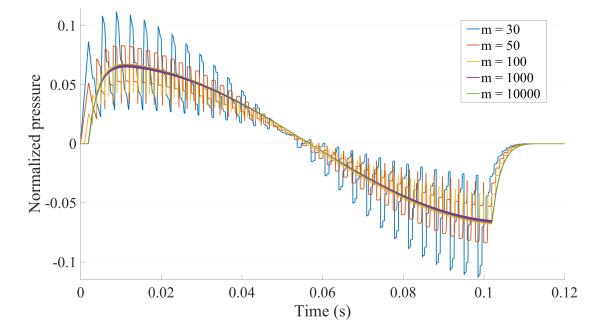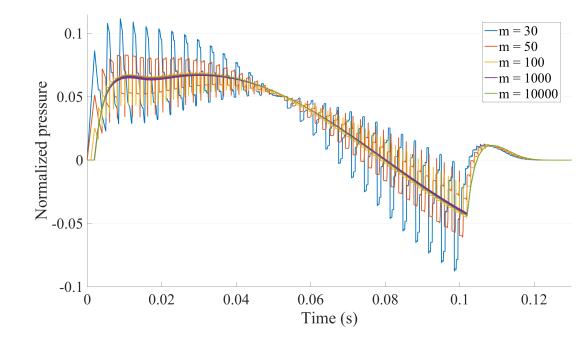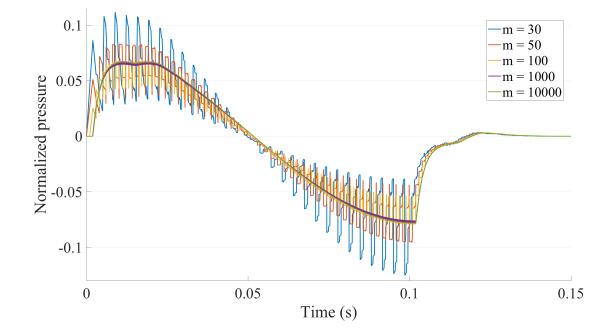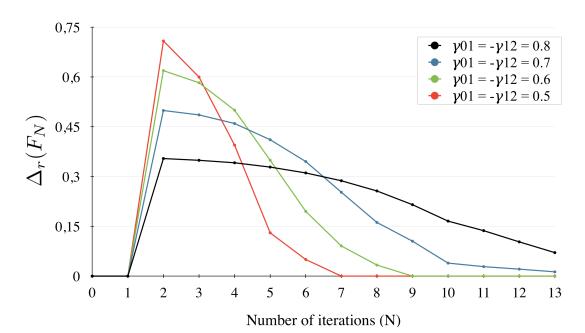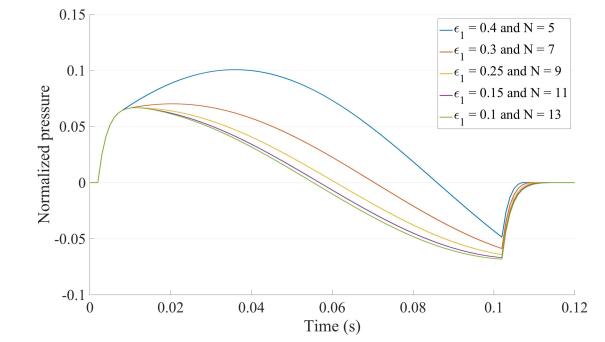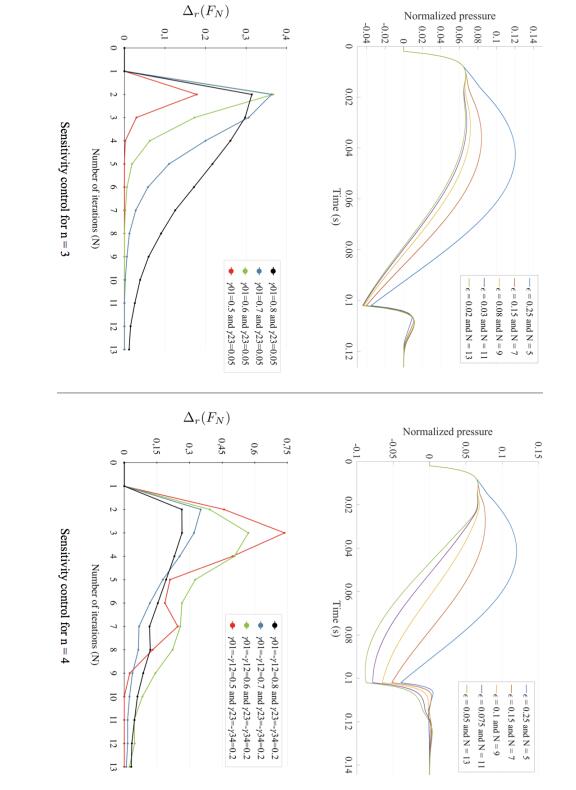1. Introduction
Blood pressure is an important source of diagnostic information that can be used to detect and characterize cardiovascular diseases. Research has shown that studying the propagation of arterial pressure wave in the cardiovascular system leads to clinically useful information [12, 25, 13, 8, 14]. For example, the distensibility of an artery can be found from the speed of the pressure wave propagation in the vessel. Moreover, when a wave encounters an irregularity in the vessel, a transmitted and a reflected wave are generated from both sides of the irregularity [3, 22]. This is particularly important because reflected waves travel backward directly to the heart. These backward waves can apply an additional load on the muscle that is often seen as a risk factor for developing heart disease [11]. Research has shown that with age, due to the stiffening of the vessels and the presence of stenoses or aneurysms, reflected waves are more and more frequent [22]. Other studies were carried out to characterize the reflection coefficients of irregularities such as stenoses [21] and to look at the effect of these irregularities on arterial pressure waves [2, 15].
In this research, we model arterial irregularities as local discontinuities in a geometric or mechanical property of the artery. The results apply to any local change in the area of the vessel, such as stenoses, aneurysms or bifurcations, and also apply to changes in other properties, such as the result of local stiffening with age due to plaques or remodelling of the arterial wall. Our model of arterial irregularities consists in an idealized system Sn, represented on Figure 1, which models a section of an artery, with n irregularities, modelled by discontinuities dk, where (k,n)∈N2 and 1≤k≤n. The scope of this research is to study the effect of successive arterial irregularities modeled by system Sn on an incoming cardiac pulse wave Pi. To do so, we investigate on the resulting reflected pressure wave Pr,n returning at the entrance of system Sn after the passing of the incoming cardiac pulse wave Pi. Thus, we introduce a measurement point, represented by point M at x=0 on Figure 1, at which level we will numerically study the evolution of blood pressure.
As represented on Figure 1, two successive discontinuities dk and dk+1 delimit a zone Zk in which the mechanical and geometric properties of the vessel are homogenous. Therefore, waves propagate in Zk without any perturbation, until they reach either discontinuity dk+1, the right delimitation of Zk, for forward propagating waves, or discontinuity dk, the left delimitation of Zk, for backward propagating waves. When reaching a discontinuity, waves split into two components : a reflected pressure wave that is reflected within Zk, represented by curled arrows on Figure 1, and a transmitted pressure wave that is transmitted in Zk−1 for backward traveling waves, or in Zk+1 for forward traveling waves, represented by straight arrows in Figure 1. Finally, Pi is the initially incoming wave that will be interfering with system Sn and that will be used as our input signal in this research. Pr,n is the overall reflected pressure wave, that will return at the entrance of Sn after the passing of Pi in system Sn, which amplitude will be numerically estimated at the measurement point M in x=0. Using the previous notation, S0 represents a homogenous vessel, S1 represents a single change, such as bifurcation and S2 could be used to model a stenosis or an aneurysm, where there is a section with different properties between two identical sections.
Hemodynamic studies, conducted with in vivo laboratory experiments [9, 1] have been used to test theoretical models, but nowadays, computers and simulations are more frequently used. Indeed, simulations allow us to access specific values such as the wall shear stress or the pressure distribution, which are difficult to extract from in vivo experiments [24, 20, 10, 19, 16]. Moreover, as invasive cardiovascular treatments are problematic, using simulations is particularly helpful to understand these diseases and to predict potential risks of medical complications [18]. Thus, a theoretical model that uses an iterative algorithm is developed in this paper, in order to study the effect of successive arterial irregularities on cardiac pulse waves. The iterative algorithm enables us to simulate the resulting reflected pressure wave at the entrance of Sn, at the measurement point M, at x=0 on Figure 1, after the passing of the incident cardiac pulse wave denoted Pi. Finally, it is important to study the resulting reflected pressure wave returning at the entrance of Sn denoted Pr,n as it is the backward reflected pressure wave traveling upstream directly to the heart. This backward wave can apply excessive pressure on the heart and is often seen as a risk factor for developing cardiovascular diseases. Moreover, knowing the waveform of Pr,n could be useful for diagnostic purposes or for following treatment results.
2. Modelling cardiac pulse wave
2.1. Governing equations
We make the classical assumptions that the blood flow is incompressible, one-dimensional, inviscid, and we neglect gravity. Using these assumptions, the conservation of momentum is given by the Euler equation:
|
ρ(∂U∂t+U∂U∂x)=−∂P∂x,
|
(2.1)
|
where U is the axial x-component of the blood velocity, P the blood pressure and ρ its density. By applying the mass conservation equation on a differentiable element of the blood vessel:
where A(x,t) is the local cross-sectional area of the differentiable element of the blood vessel, which is the cross-sectional area of the vessel at the considered x absciss at time t. Finally, the classical tube law assumption [4, 5, 17, 14] expresses the local area as a function of pressure and position as:
|
{A(x,t)=A(P(x,t),x)∂A∂P>0
|
(2.3)
|
and is motivated by many empirical evidences [6, 7, 23]. Using the tube law (2.3), we can rewrite (2.2) in terms of P and U as:
|
∂P∂t+U∂P∂x+AAP∂U∂x=−UAxAP,
|
(2.4)
|
where:
|
Ax=∂A∂x|P and AP=∂A∂P|x.
|
(2.5)
|
Expressing (2.1) and (2.2) in canonical matrix form:
|
∂∂t(PU)+(UAAP1ρU)∂∂x(PU)=(−UAxAP0).
|
(2.6)
|
The eigenvalues of the matrix are U±c, where c=√1/ρD is the wave speed: the speed at which disturbances would propagate upstream and downstream in the absence of flow (U=0). D=AP/A is the distensibility of the vessel that characterizes the vessel's capability of being distended or stretched. Since the eigenvalues are real, the system is hyperbolic and can be solved using the method of characteristics. Finally, from 1-D wave theory, we know that, when a wave encounters a discontinuity in a property of the medium in which it is propagating, it is reflected and transmitted on both sides of this discontinuity. In order to characterize the reflected and transmitted wave, we will use the reflection and transmission coefficients defined by:
where Pi is the amplitude of the incident pressure wave, Pr the amplitude of the reflected pressure wave and Pt the mplitude of the transmitted pressure wave. These reflection and transmission coefficients are linked by the relation γ+λ=1 [21]. This relation allows us to study the reflected pressure only as a function of reflection coefficient γ in the result section.
In this paper, we model two successive irregularities by two discontinuities dk and dk+1 which delimit an homogeneous zone denoted Zk as represented in Figure 1. A zone Zk is fully characterized by its length Lk=dk−dk−1 and by its constant distensibility Dk. By convention, zone 0, Z0 is the semi-infinite zone at the left of the first discontinuity d1 of system Sn and zone n, Zn is the semi-infinite zone at the right of the last discontinuity dn of the system. The reflection and transmission coefficients at a discontinuity, defined above, depend on the direction of travel of the incident wave. In the following, a forward traveling wave in Zk will interact with the discontinuity dk+1 to generate a backward reflected wave in Zk with the reflection coefficient γkk+1 and a forward transmitted wave in Zk+1 with the transmission coefficient λkk+1. Similarly, a backward wave in Zk will interact with the discontinuity dk generating a forward reflected wave in Zk with the reflection coefficient γkk−1 and a backward transmitted wave in Zk−1 with the transmission coefficient λkk−1. The time for a wave to propagate downstream through Zk, from dk to dk+1 is denoted T+k, and upstream through Zk from dk+1 to dk is denoted by T−k with :
|
T+k=Lkck+U=|dk−dk−1|√1/ρDk+U and T−k=Lkck−U=|dk−dk−1|√1/ρDk−U.
|
(2.8)
|
Moreover, as the blood flow velocity is negligible compared to the celerity of pressure waves, we have U/ck≪1, therefore :
|
T±k=Lkck±U=Lkck(1±Uck)=Lkck(1±O(Uck)).
|
(2.9)
|
Under a zeroth-order approximation we can define a unique propagation time Tk for backward and forward traveling waves that is :
|
Tk=Lkck=|dk−dk−1|√1/ρDk.
|
(2.10)
|
Finally, All the properties for each zone Zk are represented in this one quantity and, in the following, Tk will be used as our model input prescribed in the simulations when modelling different pathological scenarios in the results section. By convention, T0 is the time for the wave to travel from measurement point M (at x=0 in Z0) to the first discontinuity d1 of the system.
2.2. Theoretical framework
Assume n∈N and Sn is a system modelling the section of a vessel with n arterial discontinuities, and f is a continuous function on [0,T] where T∈R+ modelling a realistic cardiac pulse wave. We want to know the resulting reflected pressure wave at the entrance of system Sn after the passing of a cardiac pulse wave. This resulting reflected pressure wave at the entrance of Sn is called the response of system Sn and is denoted Pr,n. In order to study the response of the Sn, we model the effect of the system as a functional denoted Fn that will be applied to the continuous function f(t) modelling the incoming cardiac pulse wave on Sn, that is Pr,n=Fn[f].
First we study the response of Sn when the incident wave is a single wavefront modelled by the Heaviside function. Since the governing system (2.5) is hyperbolic, wavefronts will be reflected and transmitted within the system and thus the resulting pressure at the entrance of the system is a superposition of shifted Heaviside functions with different amplitudes. In mathematical terms we write:
|
Fn[H](t)=∞∑p=1IpH(t−tp),
|
(2.11)
|
for all n∈N∗ and t∈R+ and where Ip is the amplitude and tp is the delay time of wave wp.
In the case in which the incident wave is a continuous function f defined on [0,T], we approximate f with fm, where fm is a superposition of Heaviside functions, for which limm→∞||f−fm||∞=0 which we define mathematically by:
|
∀t∈[0,T] fm(t)=m∑k=1αkH(t−t′k),
|
(2.12)
|
where m∈N and m>1, t′k=(k−1)Tm−1,t′m=T, αk=f(kTm−1)−f((k−1)Tm−1), and αm=f(T). As we mentioned, fm converges uniformly towards f when m goes to infinity. Before each simulation, a convergence study is done in order to control the convergence of fm towards f. In the results section we choose a value of m=10000 for all simulations to ensure an appropriate convergence of the Heaviside approximation of the incident wave. The effect of the control parameter m on the computational solutions is discussed in the appendices.
From equation (2.8), by using the linearity and the continuity of the functional Fn and by using the expression of Fn[H] from equation (2.7), we find:
|
Fn[f]=Fn[limm→∞m∑k=1αkH(t−t′k)]=limm→∞m∑k=1∞∑p=1αkIpH(t−t′k−tp).
|
(2.13)
|
Thus we focus on finding the unknowns Ip and tp. In order to solve this problem we wrote an iterative algorithm that returns Ip and tp for p∈[[1,N]], where N∈N is the number of iteration for which we consider the iterations have converged. The iterative algorithm that returns the unkowns Ip and tp is explained in the two following subsections. Before each simulation, a second convergence study is done in order to control the convergence of the iterative algorithm, and in order to choose the sufficient number of iterations for the algorithm to converge. To do so, we introduce a second control parameter ϵ that controls the difference between two iterations. We denote by Fn,N[f] the result returned at the Nth iteration and Δr(FN) the relative difference between Fn,N[f] and Fn,N−1[f]. Mathematically the final number of iteration N for which the iterative algorithm has converged is such that:
|
Δr(FN)=‖Fn,N[f]−Fn,N−1[f]Fn,N−1[f]‖∞=‖limm→∞m∑k=1αkINH(t−t′k−tN)limm→∞m∑k=1N−1∑p=1αkIpH(t−t′k−tp)‖∞<ϵ
|
(2.14)
|
In the result section, we apply this method to physiological scenarios and choose ϵ = 0.1 for each simulation to control the convergence of the algorithm. A senstitivity analysis regarding ϵ is detailed in the appendices.
2.3. History of the waves
In this section, we consider wavefronts propagating in system Sn and returning to the entrance, which are the waves that are transmitted from Z1 to Z0. The history of a particular wave can be written in different but equivalent ways: the sequence of zones traversed, the sequence of discontinuities encountered or, most conveniently for our purposes, the sequence of reflections/transmissions that the wave has undergone. Indeed, a wavefront propagating in the system is fully characterized by its list of reflection and transmission coefficients of all the reflection and transmission it went through at each discontinuity dk within the system. For wave wp, its reflection/transmission coefficient list is denoted as ~wp in the following, often called "the history of wave wp". We illustrate S3, the system with three discontinuities, in Figure 2.
In the (x,t)-diagram plotted in Figure 2, vertical dashed lines represent the borders of the different homogenous zones, delimited by the discontinuities of the system, while diagonal lines represent the different paths of the waves traveling within the system. The slope of the diagonal lines is constant within a homogenous zone, and is equal to the speed of propagation of a wave through this zone.
We consider returning wavefronts in the (x,t)-diagram of Figure 2 and write down their respective reflection/transmission coefficient list as examples. The returning wavefront w1 at time t=2T0 has only been reflected on Z1 coming from Z0. Its list is ~w1=(γ01). The returning wavefront w2 at time t=2T0+2T1 has been transmitted from Z0 to Z1 through d1, reflected at Z2 while in Z1 and finally transmitted back to Z0 from Z1 through d1. Its list is ~w2=(λ01,γ12,λ10). The returning wavefront w3 at time t=2T0+4T1 has the same history as the previous wavefront, except it is reflected two more times in Z1: at Z0 the first time and at Z2 the second time. Thus, its list is ~w3=(λ01,γ12,γ10,γ12,λ10). Using the same notation, the returning wavefront w4 at time t=2T0+2T1+2T2 has the list ~w4=(λ01,λ12,γ23,λ21,λ10), and so on.
If we know the history of a wavefront returning at the measurement point M at x=0 then we know the time of arrival and amplitude of the wave. Indeed, for instance, according to the definition of the reflection and transmission coefficients (2.6), if we consider the wavefront w1 that is directly reflected on discontinuity d1 between Z1 and Z2, it returns to the measurement point with the amplitude γ01 and it took 2T0 to return as it traveled back and forth into Z0. Similarly, wavefronts that are transmitted through d1 from Z0 to Z1 has their amplitude firstly multiplied by λ01, and if we consider the wavefront w2 that is then reflected on d2 between Z1 and Z2, and then transmitted back through d1 from Z1 to Z0, its amplitude is therefore multiplied by the reflection coefficient between Z1 and Z2 which is γ12 and then by the transmission coefficient from Z1 and Z0 which is λ10. Thus, the amplitude of the returning wavefront w2 is given by the product I2=λ01⋅γ12⋅λ10, and its time of return is the summation of the different back and forth traveling times through Z0 and Z1 that is t2=T0+T1+T1+T0=2T0+2T1. Therefore, the history of the wavefronts enables us to find tp and Ip for any wavefront wp. Indeed, according to the definition of the reflection and transmission coefficients, if we know the lists ~wp of reflection/transmission coefficients of any returning wavefront wp, then we know its amplitude as it is given by:
|
∀p∈[[1,N]], Ip=∏(i,j,k,l)λij∈~wpγkl∈~wpλij⋅γkl,
|
(2.15)
|
Moreover, the time for a wavefront to return is, by definition, and as we saw in the previous examples, the summation of the different back and forth traveling times the wave goes through in the system before returning. Therefore, this can be mathematically defined as:
|
∀p∈[[1,N]],tp=∑(i,j)λij∈ ~wpγij∈ ~wpTi,
|
(2.16)
|
where N is the number of iterations.
In this research, we developed an iterative algorithm returning all the lists ~wp which enables us to compute Ip and tp for any wave wp and thus determine Pr,n. The method is explained in the following section. Then, this algorithm will be applied to different physiological scenarri that are presented with the computational solutions in the results section.
3. Method
3.1. Explaining the algorithm for 3 discontinuities, n=3
The algorithms for determining the lists ~wp for S1 and S2 are too simple to indicate how to develop an algorithm for systems with more discontinuities. The study of a system with 3 discontinuities, S3, however is not trivial and does provide us with a method that can be generalized to larger systems. Thus, the study of system S3 with three discontinuities (n=3) is important because we will see how from the study of this system we can easily have the response for any other systems with any number of discontinuities. An illustration of S3 is given in Figure 2. We study the first reflection/transmission coefficient lists of the wavefronts that are returning the entrance of system S3. We stored the lists by their lengths (i.e: the number of elements in the list, which is the number of reflection and transmission coefficients) into matrices. The matrices are denoted Mn,l where n is the number of discontinuities of system Sn and l the length of the coefficients lists of the matrix (thus the number of columns of the matrix). We first noticed that the length of a list, l, can only be an odd number for the wavefront to return at the entrance of the system. We were able to write down manually the first five matrices of the returning wavefronts:
|
M3,5=(λ01γ12γ10γ12λ10λ01λ12γ23λ21λ10),
|
|
M3,7=(λ01γ12γ10γ12γ10γ12λ10λ01γ12γ10λ12γ23λ21λ10λ01λ12γ23λ21γ10γ12λ10λ01λ12γ23γ21γ23λ21λ10),
|
and,
|
M3,9=(λ01γ12γ10γ12γ10γ12γ10γ12λ10λ01γ12γ10γ12γ10λ12γ23λ21λ10λ01γ12γ10λ12γ23λ21γ10γ12λ10λ01γ12γ10λ12γ23γ21γ23λ21λ10λ01λ12γ23λ21γ10γ12γ10γ12λ10λ01λ12γ23λ21γ10λ12γ23λ21λ10λ01λ12γ23γ21γ23λ21γ10γ12λ10λ01λ12γ23γ21γ23γ21γ23λ21λ10).
|
We build larger matrices iteratively using submatrices from previous matrices. We consider the matrix An∈Mn,3 with n identical rows equal to (λ01,γ12,γ10), the matrix Bn∈Mn,4 with n identical rows equal to (λ01,λ12,γ23,λ21) and the matrix Cn∈Mn,4 with n identical rows equal to (λ01,λ12,γ23,γ21). We now define the matrices M[1]3,7 which is equal to M3,7 with its first column removed and M[1,2]3,7 which is equal to M3,7 with its first and second columns removed. Thus, we can express M3,9 as:
Furthermore, we show by induction that for any p>3:
Thus we develop an iterative algorithm that is able to generate automatically all the matrices, thus all the reflection/transmission coefficient lists of the returning wavefronts, stored in the matrices. From these coefficient lists, we can easily get the values of the unknowns Ip and tp using equation (2.10) and equation (2.11). By doing so, the problem is solved for system S3 with three discontinuities. Moreover, both system S1 with one discontinuity and S2 with two discontinuities are also solved. Indeed, S1 (resp. S2) is only a particular cases of S3 for which the reflection and transmission coefficients γ12, γ23 and λ12, λ23 (resp. γ23 and λ23) are equal to 0.
3.2. Extending the algorithm from 3 discontinuities to 4 discontinuities, n=3 to n=4
Reflection/transmission coefficients lists for S3 also represent returning waves in S4. Any additions to the lists in S4 compared to the one with S3 occur because the wavefront reached d4. With the presence of the discontinuity d4 in S4, wavefronts can now be transmitted through d3 and still be returning at the entrance of S4 if reflected on d4. System S4 is illustrated in Figure 3.
When a wavefront is transmitted through d3 in zone Z3, a returning wavefront will be transmitted back to Z2 after an odd number of reflections in Z3. Finally, a returning wavefront for S4 cannot be transmitted through d4 as there are no more discontinuities after d4 to be reflected on.
This idea was transplanted into the algorithm. For a wavefront to be propagating in Z2 in the positive x-direction, its last reflection and transmission were either the reflection from in Z2 on d2 or the transmission from Z1 to Z2 through d2. This means that the last term of its wave history is either γ21 or λ12. In order to generate all the new coefficient lists of the returning wavefronts for S4 from the previously generated matrices for S3 we simply have to add to any lists containing γ21 or λ12 in the matrices of S3 the following sequence of coefficients due to:
● The transmission from Z2 to Z3 through d3: λ23.
● The odd number of reflection in Z3 on d3 and d4: (...γ34,γ32,...,γ34,γ32,...,γ34,γ32,γ34,...).
● The final transmission from Z3 to Z2 through d3: λ32.
We finally have analogous matrices from the one obtained in the previous study of S3 with additional lines, written in bold in the following, due to the presence of the new discontinuity d4:
|
M4,5=(λ01γ12γ10γ12λ10λ01λ12γ23λ21λ10),
|
|
M4,7=(λ01γ12γ10γ12γ10γ12λ10λ01γ12γ10λ12γ23λ21λ10λ01λ12γ23λ21γ10γ12λ10λ01λ12γ23γ21γ23λ21λ10λ01λ12λ23γ34λ32λ21λ10),
|
and,
|
M4,9=(λ01γ12γ10γ12γ10γ12γ10γ12λ10λ01γ12γ10γ12γ10λ12γ23λ21λ10λ01γ12γ10λ12γ23λ21γ10γ12λ10λ01γ12γ10λ12γ23γ21γ23λ21λ10λ01λ12γ23λ21γ10γ12γ10γ12λ10λ01λ12γ23λ21γ10λ12γ23λ21λ10λ01λ12γ23γ21γ23λ21γ10γ12λ10λ01λ12γ23γ21γ23γ21γ23λ21λ10λ01γ12γ10λ12λ23γ34λ32λ21λ10λ01λ12λ23γ34λ32λ21γ10γ12λ10λ01λ12λ23γ34λ32γ21γ23λ21λ10λ01λ12γ23γ21λ23γ34λ32λ21λ10λ01λ12λ23γ34γ32γ34λ32λ21λ10).
|
4. Results for a half-sinusoidal model of a cardiac pulse wave
In the following section, we are going to look at the reflected pressure versus time Pr,n(t) at the entrance of systems with different numbers of discontinuities, when the incident pressure wave is modeled by a half-sinusoidal wave : Pi(t)=sin(πt/0.1). We will consider cases of 1, 2, 3 and 4 discontinuities in the system. Each study is directly linked to common physiological scenarios. The results are given by simulations obtained with the previously explained algorithm and after a convergence study done on the two control parameters. We chose in the following simulations m=10000 and ϵ=0.1 as explained in the theoretical framework. Detailed sensitivity studies regarding the values of the control parameters m and ϵ are given in the appendices for cases with n=2, n=3 and n=4.
4.1. Results for one discontinuity (n =1): Application to a bifurcation or an abrupt change in stiffness
Applying the algorithm to system S1 can be useful to model a bifurcation or an abrupt change in the vessel's stiffness as both can be modelled with a system with only one discontinuity. We looked at the results for different values of reflection coefficients and saw that the results obtained from the algorithm matched with the trivial analytical solution Pr,1(t)= γ01Pi(t)= γ01sin(πt/0.1). This comparison allowed us test and valid the algorithm on this example.
4.2. Results for two discontinuities (n = 2): Application to an isolated stenosis or an isolated aneurysm
In this section we apply the algorithm to system S2, the system with two irregularities. This is particularly useful to model isolated stenoses or isolated aneurysms. Indeed, these pathologies can be modelled by two successive changes in the vessel's area as the flow undergoes a narrowing which induces a discontinuity in the local area. On Figure 4 are gathered the results of the simulations modelling the reflected pressure at the entrance of an isolated stenosis for different severities by changing the values of the reflection coefficients γ01 and γ12. In this particular example, we were able to derive an analytical solution of the reflected pressure (see appendix 6.1). We compared the analytical solution with the results returned by the algorithm by plotting the analytical solution in dashed line on Figure 4 for γ01=γ12=0.8. We see that the analytical (dashed lines) and the computational responses match, which validates once more the algorithm. The fact that the analytical and the computational solutions are not identical is due to the degree of convergence of the iterations controlled by the parameter ϵ. As ϵ⟶0, the computational solution uniformly converges towards the analytical solution as we can see on Figure 12 in the appendices, but computation times increase rapidly. Fixing the value of ϵ was done by choosing the right balance between computation times and the exactness of the computational solutions. In our simulations, we fixed ϵ=0.1 because computations are executed fast enough to investigate on different scenarios and we are satisfied of the precision of the computational solutions returned by the algorithm. In these simulations we chose as input parameters : T0=1 ms and T1=0.5 ms, which corresponds to a 5 mm long stenosis.
4.3. Results for three discontinuities (n=3): Application to a stenosis followed by a bifurcation
For a number of discontinuities strictly greater than 2 (n>2), there are no general analytical solution. This justifies our need to develop the iterative algorithm. Applying the algorithm on system S3 can be helpful to study the influence of a bifurcation downstream a stenosis. As bifurcations have commonly low reflection coefficients we fix at 0.05 the value of the bifurcation's reflection coefficient. On Figure 5 are gathered the simulated reflected pressure waveforms at the entrance of system S3 modelling stenoses with different degrees of severity followed by a bifurcation. In these simulations we chose as input parameters: T0=1 ms, T1=0.5 ms and T2=6 ms which corresponds to a 5 mm long stenosis followed by a bifurcation 6 cm downtream.We notice that the amplitude of the reflected pressure waveform for all scenarios is around 0.05 except for the case γ01=0.8. This means that for 0≤γ01≤0.6, the amplitude of the incident pressure wave is multiplied by the value of the bifurcation's reflection coefficient. Moreover, we observe a local minima in pressure near t=100 ms for all scenarios, except for the case γ01=0 which is the case equivalent to no upstream stenosis. This let us think that this peak is due to the presence of the upstream stenosis as we can also see on Figure 4 the waveform for an isolated stenosis reaching its minimal values near t=100 ms.
4.4. Results for four discontinuities (n = 4)
4.4.1. Application to two stenoses in series
Modelling the reflected pressure waveform upstream two stenoses in series is particularly useful because in some cases, one stenosis can hide a second downstream stenosis. This can easily be modelled using S4, the system with four discontinues because two stenoses in series can be seen as four successive discontinuities in the vessel's area. We fix the reflection coefficients corresponding to the dowstream stenosis and vary the coefficients of the first stenosis to investigate different scenarios. Results are gathered on Figure 6. For these simulations, we chose as input parameters: T0=1 ms, T1=0.5 ms, T2=6 ms and T3=0.5 ms which corresponds to a first 5 mm long stenosis spaced 6 cm away from a second 5 mm stenosis downstream. The main difference with the case of one isolated stenosis is the presence of local extrema observed on the returning pressure waveform. A local minimum is observed at time t=16 ms that matches with the time for a single wavefront to reach the downstream stenosis and to return back to where the pressure is recorded. We suppose that this local minimum is due to the presence of the downstream stenosis as it was not observed in the case of an isolated stenosis. Observing such local extrema in the reflected pressure waveform could be helpful to detect stenoses in series and could have important clinical implications explained in the discussion section.
4.4.2. Application to smooth changes in vessel's stiffness
Modelling an abrupt change in stiffness was done with n=1 discontinuity using S1. However, one could expect, in some cases, the changes in stiffness along an artery to occur relatively smoothly. A smooth transition can be modelled by discretizing the progressive change in the arterial property with several local discontinuities in the arterial stiffness. This number of discontinuities depends on how one discretizes this progressive change. The more discontinuities you consider, the better will be the discretization. In our case, we model a smooth change in stiffness by discretizing this progressive change with four localized discontinuities in stiffness that are characterized by their relative reflection coefficients. To do so, we consider system S4 with four discontinuities that all have the same relative reflection coefficients γ and for which the propagation times of the pressure wave to travel between two successive discontinuities are the same and are equal to a parameter denoted ΔT on Figure 7. ΔT is directly related to the gradient of stiffness of the artery and can physically describe how smooth is the change in the vessel's property. The more ΔT is important, the more the discontinuities are spaced and thus, the less the gradient in stiffness of the artery is important as the different reflection coefficients are fixed and equal to γ. On Figure 7 are gathered results of simulations for which we consider the four reflection coefficients fixed and equal to γ=0.1 and where we study the effect of ΔT on the reflected pressure waveform. In our case we observe that the more ΔT is important, the less the amplitude of the reflected wave is important. This means that the amplitude of the reflected pressure wave decreases with the stiffness gradient as we could physically expect. Interpretations of this result are gathered in the discussion section.
5. Discussion and conclusion
This research presents a method that allows clinicians to have qualitative predictions of the resulting reflected pressure waveform upstream a series of successive arterial irregularities. The iterative algorithm developed in this paper is used to model different clinical scenarios and simulate the effect of arterial irregularities, such as stenoses or arterial stiffening, on the pressure waveform. The results we obtained for a single stenosis with the algorithm were compared with the analytical solution developed in the appendix. This comparison allowed us to test the robustness of the algorithm and validate the method we use in this research. The algorithm is applied on more complicated physiological cases than isolated stenoses, such as a stenosis followed by a bifurcation. In that case, the global amplitude of the pressure is multiplied by the reflection coefficient of the downstream bifurcation. Usually, the reflection coefficients of bifurcations are relatively small, around 0.05. Measuring normalized reflected pressure wave with small amplitudes could indicate clinicians the presence of a bifurcation near the measurement point.
We also applied our method to two stenoses in series, which could prevent a stenosis hiding a second downstream stenosis during diagnosis, meaning that only the first stenosis is treated and potentially necessitating a second operation. If clinicians were able to detect directly both stenosis, only one operation would be needed, limiting the risks and the time of the medical procedure. Our model shows that when two stenoses are in series, the reflected pressure looks similar to the case of isolated stenoses but visible local pressure extrema indicate the presence of the second downstream stenosis. From such information, clinicians could directly look for two stenoses instead of one. However, in practice, noise could easily make the local extrema difficult to measure as their amplitude are relatively small compared to the global amplitude of the reflected pressure wave. This would suppose a measuring device able to detect small pressure variations in the blood flow while filtering undesirable noise. At this point, no experimental work has been done. Yet, from the theoretical results of this research, we understand that an experimental study would need precise measuring tools and techniques in order to detect the impact of such arterial irregularities on the pressure waveform.
Finally we investigate on a progressive change in the vessel's properties. We apply the algorithm on smooth changes in stiffness of the vessel's wall. Results show that the less the gradient stiffness is important, the weaker will be the reflected wave. The limit case of infinitely smooth changes in the vessel's properties being the case of a regular uniform vessel in which no reflected wave is generated. The same method of discretizing progressive changes in the vessel's stiffness can be used to model smooth changes in the vessel's area in order to study more realistic stenoses' and aneurysms' geometries which are commonly modeled by an abrupt change in the vessel's area. However, the main limitation with this discretizing technique is that to have a good approximation of a progressive change in vessels' properties, one need to consider many discontinuities which quickly leads to long computation times.
6. Appendices
6.1. Analytical solution of the returning pressure wave for an isolated stenosis or an isolated aneurysm
In the following we consider a system with two discontinuities S2 modelling an isolated stenosis or an isolated aneurysm for which γ01=γ12. To ease up the notation we take γ01=γ12=γ. We look for the response of S2 when the incoming pressure wave traveling initially forward through Z0 is modelled by the Heaviside function H. At time t=T0, it reaches the first discontinuity d1 of S2, where a reflected wave is generated with amplitude γ which travels backward to the measurement point M (Figure 1). The reflected wave reaches the measurement point at time t=2T0. Thus :
|
∀t∈[0,2T0[ Pr,2(t)=1.
|
(6.17)
|
When the incoming wave reached d1 at t=T0 a transmitted wave was also generated, traveling forward through Z1 with amplitude 1+γ. When this transmitted wave reaches d2 at time t=T0+T1 a reflected wave is generated, traveling backward through Z1 with an amplitude of (1+γ)(−γ) which reaches d1 at time T0+2T1. At this time a transmitted wave is generated and travels through Z0 with the amplitude (1−γ2)(−γ) and reaches the measurement point at time t=2T0+2T1. Thus we can write:
|
∀t∈[2T0,2T0+2T1[ Pr,2(t)=1+γ.
|
(6.18)
|
This reflection process within Z1 goes on infinitely and new waves are transmitted to the measurement points every 2T1. Thus we can write:
|
∀t∈[2T0+2T1,2T0+4T1[ Pr,2(t)=1+γ+(1−γ2)(−γ)
|
(6.19)
|
and more generally :
|
∀n∈N∗∀t∈[2T0+2nT1,2T0+2(n+1)T1[ Pr,2(t)=1+γ+(1−γ2)n∑k=1(−γ)2k−1.
|
(6.20)
|
By induction we get the general formula for Pr,2(t) when the incoming wave is modelled by the Heaviside function H:
|
∀t∈R∗+ Pr,2(t)=H(t)+γH(t−2T0)+(1−γ2)∞∑k=1(−γ)2k−1H(t−(2T0+2kT1)).
|
(6.21)
|
Knowing the response of S2 for an incoming wave modelled by the Heaviside function, one can know the response of S2 for any continuous function as explained in section 2.2. From this analytical method we are able to control and validate the results returned by the algorithm for n = 2 (Figure 4).
6.2. Analysis on the speed of convergence for two discontinuities (n=2) as a function of the reflection coefficient γ
We know from equation (6.5) the analytical solution of the reflected pressure for n=2, that can be used, for example, to model an isolated stenosis. The first term H(t) represents the input wave that is modelled by the Heaviside side function for the single wavefront analysis developed above. The second term γH(t−2T0) comes from the reflection of the input wave before entering in the stenosis. The third and last term (1−γ2)∑∞k=1(−γ)2k−1H(t−(2T0+2kT1)) describes the multiple reflections and transmissions occurring within the stenosis. In order to study the asymptotic behavior of Pr,2 and its speed of convergence, we will study the sequence defined by the last term:
|
∀N∈N∗ uN=(1−γ2)N∑k=1(−γ)2k−1.
|
(6.22)
|
The sequence is a geometric series with a common ration of γ. As we saw in the previous part, γ represents the reflection coefficient between Z0 and Z1, thus, γ∈[0,1[ (the case in which γ=1 being the trivial case when the stenosis is fully blocked). The fact that 0≤γ<1 indicates that the series converges, as expected. Moreover, as γ≠1, we can rewrite this geometric series as:
|
∀N∈N∗ uN=−γ(1−γ2)1−(γ2)N1−γ2=−γ(1−γ2N).
|
(6.23)
|
In order to study the speed of convergence we consider the following sequence :
|
∀N∈N∗ ΔuN=uN−uN−1=(γ2−1)γγ2N.
|
(6.24)
|
For α=(γ2−1)γ we have that :
|
∀N∈N∗ ΔuN=α⋅γ2N=α⋅e2Nln(γ)=α⋅e−Nτ
|
(6.25)
|
where,
is the characteristic number of iterations for convergence that characterizes the speed of convergence. This relation between τ and γ gives us the speed of convergence as a function of γ for two discontinuities (n = 2).
6.3. Numerical sensitivity analysis of the control parameters m
The effect of parameter m on the computational solution is clearly visible. As m increases, the computational solution converges towards the analytical solution as expected. On the following Figures, we plotted the same results obtained in Section 4.2, 4.3 and 4.3 but for different values of m. We see that the algorithm converges but a low discretization using Heaviside functions (m<1000) leads to a noisy computational solution. For that matter, we chose in our previous simulations of the results section m=10000.
6.4. Numerical sensitivity analysis of the control parameter ϵ
6.4.1. Numerical sensitivity analysis of the control parameter ϵ for two discontinuities n=2
In the case with two discontinuities (n=2), the dynamics of the algorithm convergence can be studied by looking at the evolution of the relative difference between F2,N[fm] and F2,N−1[fm], which was previously introduced and denoted Δr(FN), as a function of the number of iterations N. This evolution is plotted on Figure 11 on which we can see that the algorithm converges after a certain amount of iterations.We also see that the sufficient number of iterations for having Δr(FN)<ϵ for a given ϵ, depends on the value of the reflection coefficient γ01. As the reflection coefficient increases, the time for the algorithm to converge is more and more important. Therefore, for the simulations in the results section, we chose the optimal number of iterations for which Δr(FN)<ϵ in the case where γ=0.8. Indeed, as γ=0.8 is the highest value of the reflection coefficient that we study, its leads to the longest time of convergence and therefore the highest number of iterations. As we chose a control parameter ϵ=0.1, the simulations were run with the optimal number of iterations which is N=12 in order to optimize computational time and still have a relevant computational solution close to the analytical one. On Figure 12 is plotted the computational solution for different value of the control parameter ϵ. We see that as ϵ→0, the computational solution uniformly converges to the analytical solution, represented in dashed lines in Figure 12, as expected.
6.4.2. Numerical sensitivity analysis of the control parameter ϵ for more than two discontinuities n>2
Similarly, numerical sensitivity studies were done for n=3 and n=4 and results are gathered in Figure 13.









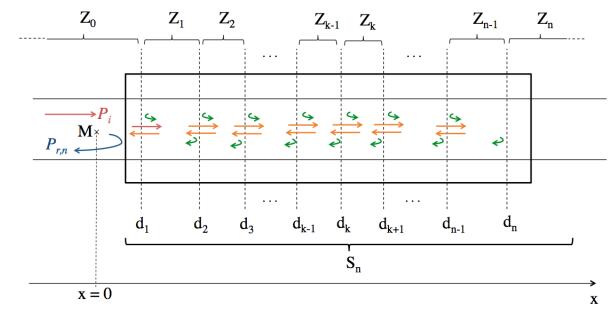
 DownLoad:
DownLoad: 